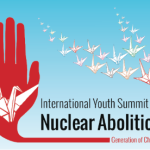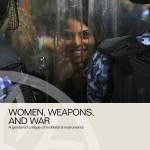On 16 October 2015, Reaching Critical Will’s Director Ray Acheson delivered the following statement to the UN General Assembly First Committee on Disarmament and International Security. The statement was endorsed by a large number of civil society organisations, listed at the end.
Courtesy: Reaching Critical Will
 The negative impacts on our society of patriarchy and male privilege are perhaps nowhere more pervasive and pernicious than in the field of weapons, war, and militarism. By consequence, much of the discussion on disarmament perpetuates the highly problematic gender constructions of men who are violent and powerful and women that are vulnerable and need to be protected. Gender perspectives in disarmament, peace, and security must be about exposing and challenging this state of affairs, not about including more women in the existing systems of structural inequalities and violent masculinities.
The negative impacts on our society of patriarchy and male privilege are perhaps nowhere more pervasive and pernicious than in the field of weapons, war, and militarism. By consequence, much of the discussion on disarmament perpetuates the highly problematic gender constructions of men who are violent and powerful and women that are vulnerable and need to be protected. Gender perspectives in disarmament, peace, and security must be about exposing and challenging this state of affairs, not about including more women in the existing systems of structural inequalities and violent masculinities.
Earlier this week, the UN Security Council convened an open debate for the fifteenth anniversary of resolution 1325. In 2000, this resolution elevated attention to the importance of women’s participation in peace and security issues. Since then, many member states and international organisations have increased efforts at “gender mainstreaming”—which for the most part has meant trying to increase the number of women in peace processes, peacekeeping missions, and the armed forces.
However, in 70 years, First Committee has only had one female chair. And recent research has shown that at any given intergovernmental meeting on disarmament, only about one quarter of participants are likely to be women, less than a fifth of statements are likely to be given by women, and almost half of all delegations are likely to be composed entirely of men.[1]
There is a disconnect between the objectives of resolution 1325 in terms of women’s participation and the objective of disarmament and arms control. The narrow interpretation of resolution 1325 as it has been implemented doesn’t really help with the prevention of armed conflict or to challenging the legitimacy of systems that generate war. Because it aims foremost to protect women in war and to ensure equal participation in the processes and negotiations that end particular conflicts, 1325 leaves war itself in place.[2] We seek to mainstream women not into the prosecution of war, but into the processes of building peace.
The idea of gender mainstreaming put forward by the women, peace and security agenda, however, has been taken up in disarmament contexts. The UN General Assembly resolutions on women, disarmament, non-proliferation and arms control; the outcome document of the fifth biennial meeting of states on the UN Programme of Action on small arms and light weapons; and the Arms Trade Treaty’s provision on preventing gender-based violence have all benefited from resolution 1325’s landmark recognition of the importance of women’s perspectives on and participation in peace and security.
But more is needed. We know that women, men, and others are often exposed to different patterns of violence. Men and adolescent boys tend to be the most frequent direct victims of armed violence. But women and others affected by violence and conflict often have less access to health care, services, and reconstruction processes. If heading the household, they sometimes face systematic discrimination and can become more susceptible to further physical attack and sexual exploitation.
We know that women and men can be impacted differently by certain weapon systems. Small arms and light weapons are frequently used to facilitate acts of gender-based violence, which disproportionately affects women. The use of armed drones, disproportionately used to target men, have given rise to an increase in female-headed households. [3]
Yet only women are considered inherently vulnerable. But they are not. Nor are women legally, politically, or physically comparable as a group to children or the elderly, with whom they are often grouped. Nor are women a homogenous group. To group all women together, and to group all women with children and the elderly, as vulnerable or as victims, is to strip 50% of the population of its agency and its diverse identities, experiences, and capacities. It also reinforces persistent constructions of women as the “weaker sex,” in need of protection by “powerful” men.
Framing women as weak and in need of protection continues to enable their exclusion from authoritative social and political roles here and elsewhere, and weakens the effectiveness of those processes. We hear calls for the “full and effective” participation of women—but what does that mean?
It is evident that the framing of women as weak and vulnerable is often used to construct a feminised and devalued notion of peace as unattainable, unrealistic, weak, and even undesirable.[4] The perception that not going to war is weak makes it more difficult for political leaders to take decisions not to embark on military action. Similarly, such constructions make it more difficult to cut military spending or engage in disarmament.
This means that even if women do participate in negotiations or discussions on matters related to peace and security, their positions or ideas are often forced to conform to the dominant perspective in order to be taken seriously. This is not to say that women bring one perspective to a conversation and men bring another. It rather highlights the gendered understandings of war and peace, weaponisation and disarmament, strength and weakness, which dictate what is considered “acceptable” by the dominant perspective in such conversations.
We need an approach to women’s participation and gender mainstreaming that seeks to prevent gender-based violence without categorising women as vulnerable victims; that promotes a positive role for women in ending conflict rather than participating in it; and that includes a critique of the gendered dimensions of militarism and armed violence. With this kind of agenda, we can help ensure that the instruments we have on both weapons and women contribute to the reduction and prevention of armed conflict and armed violence.[5]
Recommendations
We make the following recommendations:
Women must not be primarily categorised as vulnerable or innocent victims. Instruments and initiatives can recognise the differential impacts of weapons use, trade, and proliferation on women and others without rendering them helpless victims that lack agency. The motivation in documenting and highlighting differential impacts on women should be to ensure that they receive equal and adequate protection, care, rehabilitation, and participation as men in preventing and recovering from armed conflict.
Gender diversity in disarmament, non-proliferation, and arms control must promote the participation of women but also of those not conforming to dominant gender or sexuality norms. Armed violence also has differential impacts on LGBTQI people, which should be reflected in discussions about weapons, conflict, and violence. It should ensure a range of perspectives can be presented in discussions and negotiations, including critiques of dominant structural inequalities and normative framings. “Effective” participation of women and others creates space for alternative conceptions of security and ways to focus on preventing armed conflict and armed violence rather than on responding to it with military force.
Treaties, resolutions, commitments, and declarations on the production, possession, transfer, proliferation, or use of weapons must have a gender perspective. They need to take into account differential gendered impacts; gender diversity in the negotiation and elaboration of relevant instruments; and an analysis of the gendered dimensions of the challenges being confronted.
Similarly, instruments dealing with women, peace and security or women’s human rights must incorporate issues related to weapons and war. They should promote disarmament and arms control as integral to enhancing women’s human rights, preventing gender-based violence, and preventing and ending armed conflict and armed violence.
This statement was coordinated and drafted by the Reaching Critical Will programme of the Women’s International League for Peace and Freedom has been endorsed by the following organisations:
Acronym Institute for Disarmament Diplomacy
Action Works Nepal
Arias Foundation for Peace and Human Progress
Article 36
Association of War Affected Women
Assistance Advocacy Access-Serbia
Ban All Nukes generation USA
Cameroon Youths and Students Forum for Peace
Campaign Against Arms Trade (CAAT) Network, Nigeria
Caribbean Coalition for Development and the Reduction of Armed Violence
Caribbean Institute for the Rule of Law
Center for Peace Education-Miriam College
Centre for Peace, Security and Armed violence Prevention
Centre for Women in Governance
Centro de Estudios Ecuménicos
ChangeMaker, Bangladesh
Christian Council of Norway
CODEPINK Women for Peace
Communication et Développement Intégral (CDI-Togo)
Community Emergency Response Initiative
Danish Demining Group
Desarma México
Droits Humains Sans Frontières
Education Center on the Human Rights of Women, Morocco
Friends of Association of War Affected Women
Fundació per la Pau
Gender and Mine Action Programme
Global Alliance on Armed Violence
Global Network for Human Development, Nigeria
Handicap International
Hibakusha Stories
Human Survival Project
ICAN Austria
Institute for Security Studies, South Africa
Instituto de Enseñanza para el Desarrollo Sostenible, Guatemala
Instituto Promundo, Brazil
International Action Network on Small Arms
International Committee for Robot Arms Control
International Fellowship of Reconciliation, Austria
International Physicians for the Prevention of Nuclear War
International Physicians for the Prevention of Nuclear War, Nigeria
International Society of Doctors for the Environment
Kairos Foundation, Nigeria
Kikandwa Rural Communities Development Organization
Landmine Survivors Initiatives, Bosnia and Herzegovina
Lawyers Committee on Nuclear Policy
Los Alamos Study Group
Malaysian Physicians for Social Responsibility
Mines Action Canada
Nepal Peacebuilding Initiative
Nonviolence International
Norwegian People’s Aid
Nuclear Age Peace Foundation
Nuclear Information and Resource Service
Pacific Small Arms Action Group
PAX
Pax Christi International
Pax Christi Ireland
Pax Christi Institute
Pax Christi-Pilipinas
Peace and Development Women’s Coalition
Peace Movement Aotearoa
People for Nuclear Disarmament
Permanent Peace Movement
Philippine Council for Peace and Global Education
Pressenza International Press Agency
Project Ploughshares
Proposition One Campaign for Nuclear Weapons Abolition
RISE
RUMPUN
Saferworld
Scrapweapons.com
SERPAZ – Serviço de Paz
Soka Gakkai International
Swedish Fellowship of Reconciliation
Swedish Peace and Arbitration Society
The A38 Foundation of International Law
The Red Elephant Foundation
Trinidad and Tobago Red Cross
US Peace Council
Vision GRAM-International Canada-D R Congo
Western States Legal Foundation
Women Engaged in Action on 1325-Philippines
Women for Human Rights, Nepal
Women for Peace and Democracy Nepal
Women’s Institute for Alternative Development
Women’s International League for Peace and Freedom
World without Wars and Violence
Youth Association for Development, Pakistan
[1] Elizabeth Minor, Women and multilateral disarmament forums: Patterns of underrepresentation, Article 36, October 2015.
[2]Carol Cohn, “Mainstreaming Gender in UN Security Policy: A Path to Political Transformation,” in
Shirin M. Rai and Georgina Waylen (eds.) Analysing and Transforming Global Governance: Feminist
Perspectives, Cambridge: Cambridge University Press, 2008.
[3]Ray Acheson, Richard Moyes, and Thomas Nash, Sex and drone strikes: gender and identity in targeting and casualty analysis, Reaching Critical Will and Article 36, October 2014.
[4]Carol Cohn with Felicity Hill and Sara Ruddick, “The relevance of gender for eliminating weapons of mass destruction,” Beyond arms control: challenges and choices for nuclear disarmament, New York: Reaching Critical Will of the Women’s International League for Peace and Freedom, 2010, p. 147.
[5] Ray Acheson, Gender, women, weapons, and war, Reaching Critical Will of the Women’s International League for Peace and Freedom, October 2015.


